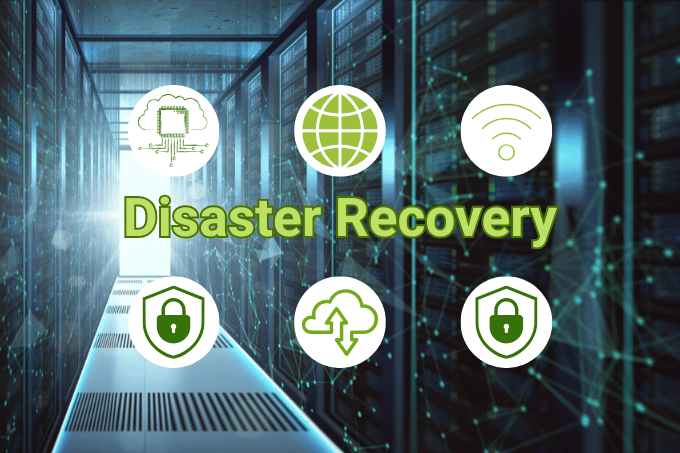What a Weak Disaster Recovery Plan Can Cost Your Data Center
Data centers often don’t invest in disaster recovery plans (DRP) until a system failure, cyberattack, or backup loss occurs. And when a plan does exist, it’s often outdated or hasn’t been properly tested.
According to a report, 71% of organizations skip failover testing, a critical step to validate if recovery protocols will work under pressure. This leads to financial loss, costly downtime, data breaches, regulatory fines, and reputational damage.
In this article, we’ll discuss how a weak disaster recovery plan can cost your business and what data centers can do to protect data, infrastructure, and long-term performance.
What Is a Disaster Recovery Plan (DRP)?
A Disaster Recovery Plan (DRP) outlines key policies, processes, and technologies a business uses to recover after unexpected disruptions. These disruptions may include cyberattacks, power failures, or data loss.
A strong DRP identifies critical systems, sets goals for how quickly operations resume, and how much data loss is acceptable. It also explains how to back up data, switch to backup systems (failover), and restore infrastructure effectively.
For example, if a ransomware attack locks a company’s servers, a DRP helps IT teams quickly switch to clean backup servers and restore recent data. This prevents days of downtime or permanent data loss.
Why Is a Disaster Recovery Plan Important?

A disaster recovery plan is a business-critical risk strategy for backing up and restoring your infrastructure.
Here’s why it’s important:
Faster Downtime Recovery
A DRP helps you adopt a structured, proactive approach. It outlines key recovery steps, helps you assign roles, and prioritizes high-impact operations first.
This allows your teams to know what systems to restore, in what order, and within what time frame.
Less Financial Risk
Unexpected IT failures expose your business to serious financial risk. It can halt your transactions or idle teams. The longer recovery takes, the greater the loss you face.
A strong DRP gives your team a clear, practiced process for restoring operations to reduce losses.
Regulatory Compliance
Regulations like HIPAA (Health Insurance Portability and Accountability Act), GDPR (General Data Protection Regulation), and PCI-DSS (Payment Card Industry Data Security Standard) require companies to adopt timely data protection and breach response.
A DRP helps you meet these regulatory obligations by defining how data is protected during and after a disruption.
Client Trust
Customers, partners, and investors expect stability. A clear, tested DRP shows you’re committed to business continuity, transparency, and resilience. It gives them the confidence that your company can recover quickly and responsibly during disasters like AI-powered cyberattacks.
Comparing the Costs: Proactive vs. Reactive Disaster Recovery
Many data centers delay disaster recovery planning due to the high upfront cost. Setting up a disaster-ready environment may require secondary servers, failover systems, cloud storage, and off-site backups. You also need redundant power, cooling, and networking.
But if disaster strikes without a plan, the cost is far worse. You need to pay for emergency IT support, system rebuilds, regulatory fines, data recovery services, and extended downtime.
For example, Delta Air Lines suffered a $150 million loss in 2016 due to a five-hour data center outage, highlighting how unplanned downtime can have massive financial consequences.
Here’s an example of how a proactive disaster recovery plan helped a company preserve its sensitive data while saving costs:
Proactive DRP in Action: Cybersecurity Incident Management
Overview
A financial institution faced a major cybersecurity breach that compromised sensitive data. The organization activated its disaster recovery plan, which included incident response procedures.
Actions Taken
- Used real-time threat detection and isolation tools
- Followed predefined response procedures
- Notified stakeholders quickly and transparently
- Switched to backup systems to maintain operations.
Outcome
The breach was contained with minimal disruption. The data was preserved, which helped maintain a strong client trust.
6 Main Steps to Creating a Disaster Recovery Plan

Here’s a step-by-step guide on how to create a strong disaster recovery plan for data centers:
1. Risk Assessment
Start by identifying potential threats, like ransomware or server crashes. You need to evaluate which systems are critical to daily operations and determine risks within your current infrastructure.
Inteleca provides disaster recovery planning services for data integrity and continuity during unexpected situations. Our IT specialists closely evaluate your hardware network, which may compromise recovery.
2. Defining Recovery Objectives
Next, your business needs to define clear targets for recovery. This includes two key benchmarks:
- Recovery Time Objective (RTO) is the maximum amount of time your business can afford for systems to be offline after a disruption. It helps you decide how quickly services need to be restored.
- Recovery Point Objective (RPO) is the maximum amount of data your business can afford to lose, measured in time. For example, the time between your last backup and the moment of failure.
These metrics help prioritize systems and define backup frequency. It also helps you understand how your infrastructure can guard against hackers during a data breach.
3. Developing Recovery Strategies
Once recovery objectives are defined, the next step is to build strategies that support them. A business’s disaster recovery plan should define step-by-step actions to restore systems and data. This includes:
- Regular cloud-based and off-site data backups
- Server failover systems that activate when the primary infrastructure goes down
- Manual workarounds for essential processes
For faster recovery, Inteleca provides data migration services to update or relocate infrastructure tailored to your workload. This allows the recovery paths to function proactively during a breach.
4. Assigning Roles and Responsibilities
Your plan should clearly define who does what during a disaster. From IT teams to communications staff, every team member should understand their role and be prepared to act.
5. Testing and Training
Run regular disaster tests to make sure your plan works practically. You also need to conduct training sessions for teams to respond quickly and confidently.
6. Continuous Updates
As your infrastructure changes, so should your DRP. Ongoing updates keep the plan aligned with current systems, threats, and compliance requirements.
3 Best Practices for Implementing a Strong Disaster Recovery Plan
Here are the best practices for implementing a strong disaster recovery plan:
1. Design a Resilient Architecture
A disaster recovery plan depends on the infrastructure behind it. Your data center needs a resilient architecture built for scalability and continuous uptime to avoid disruptions, especially during peak workload hours.
You can partner with IT experts like Inteleca to help you design a resilient architecture for recovery. Our team also helps you integrate high-performance computing solutions that support faster failover and efficient resource usage.
2. Consider Cloud-Based Disaster Recovery Options
Most modern data centers operate in hybrid or multi-cloud architectures. A cloud-based disaster recovery plan moves your data and recovery systems beyond a single physical location. This prevents total failure during local outages or site disruptions.
Cloud solutions also offer scalability, storage in different locations, and faster system recovery. This makes it easier to meet strict RTO and RPO targets without needing a second physical site.
Inteleca helps optimize infrastructure for data centers to reduce downtime and meet your business goals, whether you’re on-premise, hybrid, or fully cloud-based.
3. Monitor Your Disaster Recovery Metrics
Disaster Recovery (DR) metrics are measurable indicators that help you evaluate how well your disaster recovery plan performs. These metrics include:
- Actual recovery time: The real time it takes to bring systems back online during an incident.
- Mean time to recovery (MTTR): Your team’s average time to fully recover from system outages.
- Test frequency: How often do you run disaster recovery drills or simulations?
- Test success rate: The percentage of tests where recovery goals were successfully met.
Tracking these metrics helps you identify security vulnerabilities, improve response times, and continuously strengthen your DR strategy before a real crisis hits.
Don’t Wait for a Crisis to Act
A disaster recovery plan helps protect your business from costly downtime, data loss, and broken trust. As AI workloads increase, your data center needs recovery strategies that support your critical and non-critical systems.
But recovery isn’t something you can improvise. It takes the right infrastructure, clear processes, and regular testing for real-world scenarios.
Inteleca partners with you to create a strong disaster recovery plan that reduces risk and supports business continuity. We help data centers identify infrastructure gaps, improve network resilience, and recover faster based on your budget and needs.
Contact our team for a tailored disaster recovery plan your business can count on.



